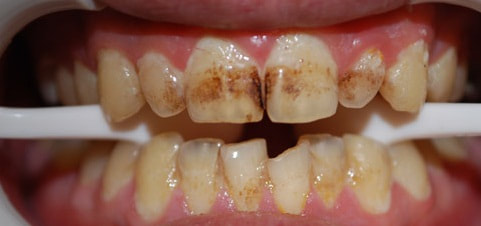|
An infant’s first tooth protrusion is a delight to watch-white in color and peeping out of the gums the tooth holds a permanent place in our hearts until the second one springs up 😊 Such milk-white teeth turns brown or yellowish in color as we age due to different reasons. The shape and size also differ from person to person. Some people might have it in the form of brown lines while it appears as blotchy, irregular patches in others. Such spots are extremely common and treatments for tooth discoloration have become a money-spinning industry with sophisticated treatment procedures and options available.
Our all-over oral health is essential for nutrients intake, communication and host defense and our teeth is involved in all three of it. Any problems with the oral cavity or teeth can cause oral infections and also make it difficult for the individual to chew/swallow food or even affect phonation/pronunciation of words and sounds. Causes Tooth discoloration is a result of different intrinsic and extrinsic causes. Dental plaque, foods, beverages, tobacco, chromogenic bacteria, topical medications and other metallic compounds are common extrinsic causes while intrinsic dental stains are the result of dental materials, dental caries, trauma, infections, medications, nutritional deficiencies and other complications such as pregnancy problems, anemia, bleeding disorders, bile duct problems, genetic problems or hereditary diseases that affect enamel development. Extrinsic discoloration is stain located on the outer layer of the tooth structure as a result of external agents. Factors such as enamel defects, improper salivation and poor oral hygiene make certain children and adults a victim of external stains. When enamel defect is the underlying root cause, it can lead to accumulation of stain-producing food, beverage, tobacco and other topical agents. Saliva is vital for oral protection aiding in cleaning of food debris and dental plaque and rarely, the salivary output decreases due to different reasons such as salivary infections, head and neck radiation therapy for cancer, chemotherapy and multiple medications such as antihypertensives and antihistamines. Above all, the main cause of extrinsic discoloration is poor oral hygiene. The lack of ability to remove the stain-producing material or insufficient cleaning and polishing actions cause discoloration. Black or brown stains are in essence due to the accumulation of dental plaque, calculus and food particles. Plaque is a sticky, colorless substance that forms on the teeth and when this is not removed with proper oral care, it can create calculus (or tartar) which cannot be removed by the individual but does need the intervention of a dental professional. Tea, coffee and other beverages can cause stain formation on the outer and inner surfaces of the teeth. Extremely dark brown and black stains are the result of tobacco stains due to cigarettes, pipes or chewing tobacco. Pan, a common betel leaf-based after-food freshener chewed commonly by people in South-Asian regions including India brings about the production of blood red saliva that causes red stains on the teeth and makes the person’s entire mouth including the lips and tongue too look red in color. Metallic compounds can also cause dental discoloration due to the interaction of the metals such as iron, manganese and silver (black discoloration); mercury and lead (blue-green); copper and nickel (green to blue-green stain) and chromic acid fumes (Deep orange) with dental plaque. Intrinsic discoloration is primarily due to dental restoration and aging also causes progressive loss of tooth enamel due to tooth wear or attrition revealing the natural yellow color of the underlying dentin. Also, frequent ingestion of acidic foods and beverages and acid regurgitation from the stomach can cause yellow tooth due to enamel erosion. This is commonly seen in patients with anorexia or bulimia due to acid reflux contact with the teeth. Trauma to developing yet unerupted teeth or trauma that occurs to fully erupted teeth can also cause discoloration. Other causes of tooth discoloration include: Foods & beverages: Dark-colored foods and beverages contain a chemical called chromogen that can stain the tooth enamel. These stains can leave a lasting mark on the teeth if the person follows a poor oral hygiene routine. Also, those food products that contain artificial colors and dyes can cause tooth stains. Nicotine & tobacco: Frequently using these products can cause particles from them to stick onto tooth enamel and develop stains. Tartar: Plaque is inevitable and each of us keep it under control by brushing and flossing. Plaque hardens into tartar or calculus when proper oral hygiene is not maintained and this can be removed only by a dental professional. Apart from this, factors such as smoking, diabetes, hormonal changes, illness or medications that cause reduction of saliva in the mouth increase the risk of developing tartar. Tooth decay: Plaque and tartar eat sugars that pass through the mouth and cause acid accumulation that can wreck the tooth enamel. As the enamel is weakened, it exposes the yellow layers of tooth below it making it appear yellowish-brown. Any small cracks or breaks in the teeth can also cause bacteria to enter and cause decay. Some people have dark spots of decay around their dental fillings or crowns when there is bacterial entry through the crevices. Genetics: Each person’s natural tooth color is different. Some might have darker-colored teeth than others. Genetic factors including the strength of the tooth enamel, enamel response to acids and pigments, exposure of enamel to constant wear and tear, hereditary conditions and developmental conditions that hinder proper bone and tooth formation can affect the color of the teeth. Treatment What causes the brown spots forms the basis for treatment. Individuals try home remedies such as brushing their teeth with baking soda and water every few days or rinsing the mouth with diluted hydrogen peroxide solution daily or every few days and rinsing the mouth again with water after that. Some over-the-counter medications that promise improvement within a week or two include:
Sadly, tooth discoloration associated with celiac disease is permanent and such long-lasting spots or discolorations can be prevented or hidden using crowns, veneers or white composite fillings. Prevention The best way to avoid tooth discoloration is to practice excellent oral hygiene. Some tips mentioned here might prove to be useful:
There are certain other foods that can strengthen enamel and prevent discoloration. Foods rich in fiber and roughage can pull off bacteria and bits of plaque off the teeth. Consuming high-fiber foods such as whole grains and cereals, veggies such as broccoli and leafy greens such as kale and spinach, foods rich in antioxidants such as carrots, ginger and garlic, nuts and high-fiber fruits and veggies such as apples, plums, pears and celery are good for your oral health and overall body health. Know your healthy fiber-rich foods from the website www.firsteatright.com and eat accordingly. Brown spots on the tooth are mostly due to poor oral hygiene, smoking or consuming dark foods and drinks. These can be removed mostly and prevented from striking our teeth again. Rarely, these spots indicate an underlying medical problem or might be the side effect of some medication. It is always recommended to approach a dentist when you are unsure about the problem at hand. Comments are closed.
|
AVOID FRAUD. EAT SMART.+91 7846 800 800
AuthorDietitian & Nutritionist Dr. Nafeesa Imteyaz. Archives
November 2022
Categories
All
Dr. Nafeesa's Blog @blogspot |
- Home
- Written Testimonials
- Consult
- Clinics
- Blogs
-
Diet & Nutrition
- Diabetes Reversal
- IVF IUI not needed for PCOS PCOD Infertility
-
Medical Nutrition
>
-
Disease & Conditions
>
- Infertility | PCOS
- Diabetes Mellitus
- Cholesterol
- Hypothyroid
- Kidney Problems
- Hypertension
- Cardiovascular Diseases
- Liver Diseases
- Gastro intestinal disorder
- Cancer
- Metabolic Disorders
- Orthopedic Disorders
- Eating Disorders
- Dietary Recall
- Weight Record Filled By Clients
- Online Payment Transaction Details
- Online Clients Weight Check Form
- Our Program Package Service Charges
- Weight Record 2017 Clients
- Measurements sent by Clients
- Terms & Conditions Of Payment
- Thanks. Your Form is Submitted
- Video Testimonials
- Lifestyle & Wellness
- Lifestyle & Wellness Blog
- Allergy & Intolerance
- Weight Loss / Gain
- Weight Loss / Slimming Blog
-
Disease & Conditions
>
- Life Cycle Nutrition >
- Sports Nutrition >
- Integrity in Nutrition
- Knowledge Centre
© COPYRIGHT 2022. ALL RIGHTS RESERVED. FRST HEALTHCARE PVT LTD.
Dr. Nafeesa Imteyaz of First Eat Right clinic, is the Best Dietitian Nutritionist in Bangalore. Best Dietitian Nutritionist in Pune. Best Dietitian Nutritionist in Hyderabad. Best Dietitian Nutritionist in Chennai. Best Dietitian Nutritionist in Mumbai. Best Dietitian Nutritionist in Delhi. Best Dietitian Nutritionist in Kolkata.


